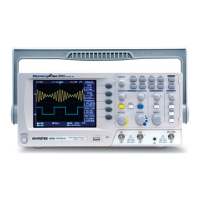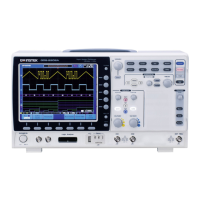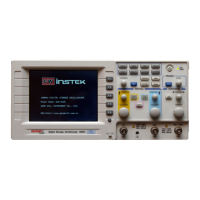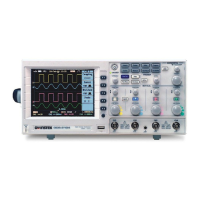CONFIGURATION
75
Trigger
The Trigger function configures the conditions by which the
oscilloscope captures the incoming signals.
Trigger type
Edge
Triggers when the signal crosses an amplitude
threshold in either a positive or negative slope.
Video
Extracts a sync pulse from a video format signal
and triggers on a specific line or field.
Pulse
Triggers when the pulse width of the signal
matches the trigger settings.
Indicators Edge/Pulse
(CH1, Edge, Rising edge,
DC coupling)
Video
(CH1, Video, Positive
polarity, NTSC standard)
Trigger parameter
Trigger source CH1, 2
Channel 1, 2 input signals
Line
AC mains signal
Ext
External trigger input
signal
Trigger mode Auto
The oscilloscope updates the input signal
regardless of the trigger conditions (if
there is no trigger event, the oscilloscope
generates an internal trigger). Select this
mode especially when viewing rolling
waveforms at a slow timebase.
GDS-1000A Series User Manual
76
The Auto trigger status appears in the
upper right corner of the display.
Single
The oscilloscope acquires the
input signals once when a
trigger event occurs, then
stops acquiring. Pressing the
Single key again will repeat
the process.
SINGLE
The Single trigger status appears in the
upper right corner of the display.
(Searching)
Normal
The oscilloscope acquires and updates
the input signals only when a trigger
event occurs.
The Normal trigger status appears in the
upper right corner of the display.
(Searching)
Holdoff
The holdoff function defines the waiting period
before GDS-1000A starts triggering again after a
trigger point. The Holdoff function ensures a
stable display.
Video standard
(video trigger)
NTSC
National Television System Committee
PAL
Phase Alternative by Line
SECAM
SEquential Couleur A Mémoire
Sync polarity
(video trigger)
Negative polarity
Video line
(video trigger)
Selects the trigger point in the video signal.
field
1 or 2
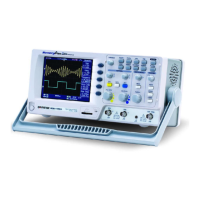
